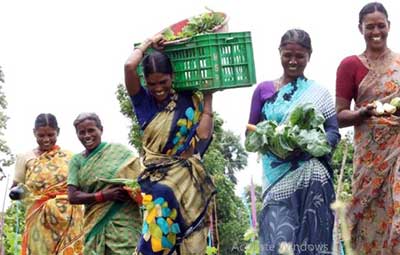Date: 04/01/2023
Relevance: GS-2: Functions and responsibilities of the Union and the States, issues and challenges pertaining to the federal structure, devolution of powers and finances up to local levels and challenges therein.
Key Phrases: Rural Development, Human Resources, Gram Panchayats, Panchayati Raj, Panchayati Raj, Socio-Economic Census, Eleventh Schedule, Funds, Functions, Functionaries.
Context:
- A report on ‘Performance-Based Payments for Better Outcomes in Rural Development Programmes’ which looked into human resources available with panchayats has suggested means by which these resources could be augmented and organised for better delivery of programmes.
Key Highlights:
- The annual ranking of Gram Panchayats on 143 parameters across human development, economic activity and infrastructure is captured each year as part of the People’s Plan campaign called ‘Sabki Yojana, Sabka Vikas’.
- It is organised by the Ministry of Panchayati Raj and Rural Development, in partnership with all the States, districts, blocks, Gram Panchayats and villages. The States have owned the initiative and find it useful.
- However, the actual use of the village/panchayat level data is still low in planning.
People’s Plan Campaign-‘Sabki Yojna Sabka Vikas
- Under Article 243 G of Constitution, Panchayats have been mandated for preparation and implementation of plans for economic development and social justice.
- Thus, Panchayats have a significant role to play in the effective and efficient implementation of flagship schemes/programmes on subjects of national importance for transforming rural India.
- With this aim, People’s Plan Campaign titled ‘Sabki Yojna Sabka Vikas’, for inclusive and holistic preparation of Gram Panchayat Development Plan (GPDP) was launched.
- The objectives of ‘Sabki Yojna Sabka Vikas’ broadly include-
- Strengthening of elected representatives and Self Help Groups,
- Evidence based assessment of progress made.
- Public disclosure on Schemes, finances etc.
- Preparation of inclusive, participatory and evidence based GPDP through structured Gram Sabha involving front line workers/ supervisors of all 29 sectors of XI schedule.
Mission Antyodaya
- Adopted in Union Budget 2017-18, Mission Antyodaya is a convergence and accountability framework aiming to bring optimum use and management of resources allocated by 27 Ministries/ Department of the Government of India under various programmes for the development of rural areas.
- It is envisaged as state-led initiative with Gram Panchayats as focal points of convergence efforts.
- Annual survey in Gram Panchayats across the country is an important aspect of Mission Antyodaya framework. It is carried out coterminous with the People’s Plan Campaign (PPC) of Ministry of Panchayat Raj and its’ purpose is to lend support to the process of participatory planning for Gram Panchayat Development Plan (GPDP).
Increasing Participation of Gram Sabha:
- Mission Antyodaya is a participatory framework developed in 2017, to assess and plan for every Gram Panchayat each year, on the basis of its deficits.
- The calendar of Gram Sabha meetings is displayed and any Indian citizen can choose to go on a surprise visit to a Gram Sabha meeting.
- Each of the 29 sectors where Gram Panchayats have a role, is requested to send their frontline worker to the meeting.
- The performance of each Department is reported to the Gram Sabha, progress is displayed on flex boards, and photographs of the meeting are uploaded on the public website.
- These meetings have become an annual feature and attendance is increasing in the Gram Sabhas.
- The Socio-Economic Census 2011 has given the details of deprived households therefore special efforts to provide pre-populated data of deprived households through an app have been made for the data collectors, who are local frontline workers/leaders
Regional variations:
- Of the 2.67 lakh GPs surveyed in 2020, only 31.27 percent secured more than 60 percent in the annual ranking of Gram Panchayats on 143 parameters.
- There are large regional variations, with 83.31 percent of panchayats securing over 60 percent in Kerala compared to only 13.75 percent in Bihar and 18.86 per cent in UP.
- Southern and Western region Gram Panchayats generally have better
scores. The decline of poverty in southern States happened on account of-
- Adolescent girls in higher education,
- Decline in fertility,
- Improvement in health services,
- Formation of SHGs,
- Access to skills and vocational courses,
- Bank loans to SHGs without collaterals.
Way Forward:
- With every Gram Panchayat having a Local Government Directory (LGD) code, it is possible to collect LGD-compliant data village institution-wise and through Application Programming Interface (API) sharing, ensure a full profile of the village and its performance.
- The SECC Household Temporary Identification Number (TIN) could be the identifier for deprived households.
- The DISHA platform for Members of Parliament provides real-time analysis on over 50 programmes that have become LGD compliant. DISHA data can be made public for greater accountability.
Conclusion:
- The groundwork for the effective decentralisation of funds, functions and functionaries for the 29 sectors listed in the Eleventh Schedule of the Constitution has been prepared.
- Human resource support to panchayats, as envisaged by the Sumit Bose Committee, needs immediate focus in States.
- Use of community owned data will need funds, functions and functionaries with local governments. The Budget can announce that major step.
Source: Business line
Mains Question:
Q. Mission Antyodaya is a pathway to an inclusive India. Analyze (150 words).






















